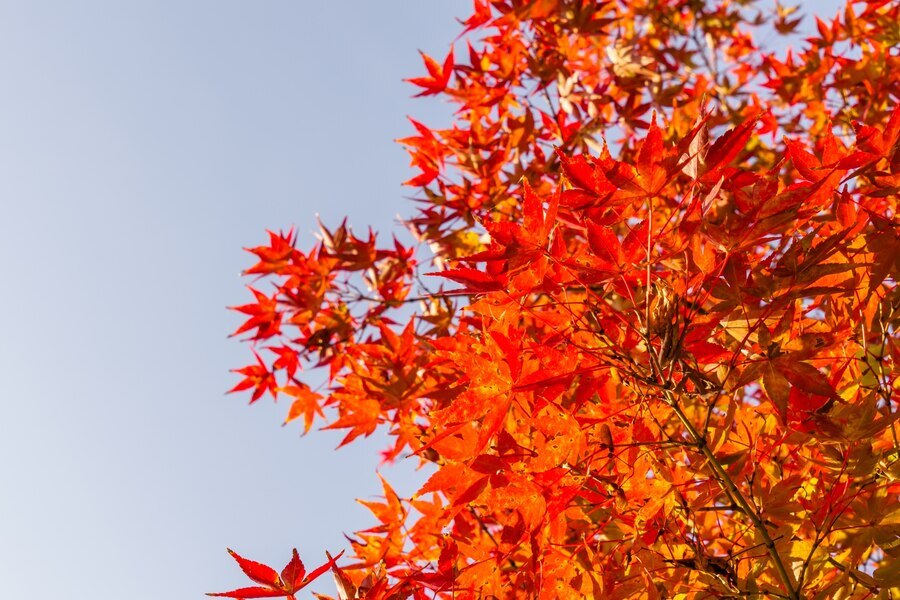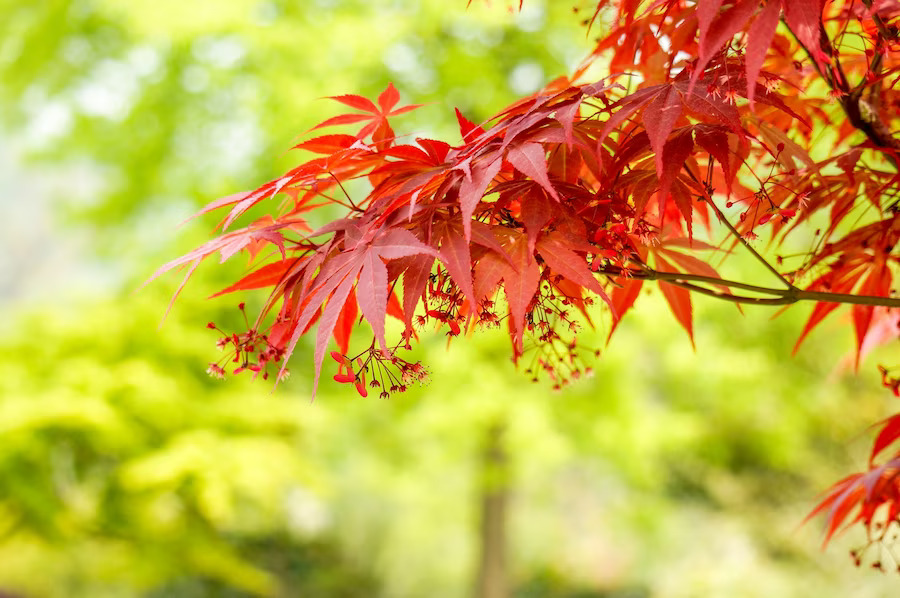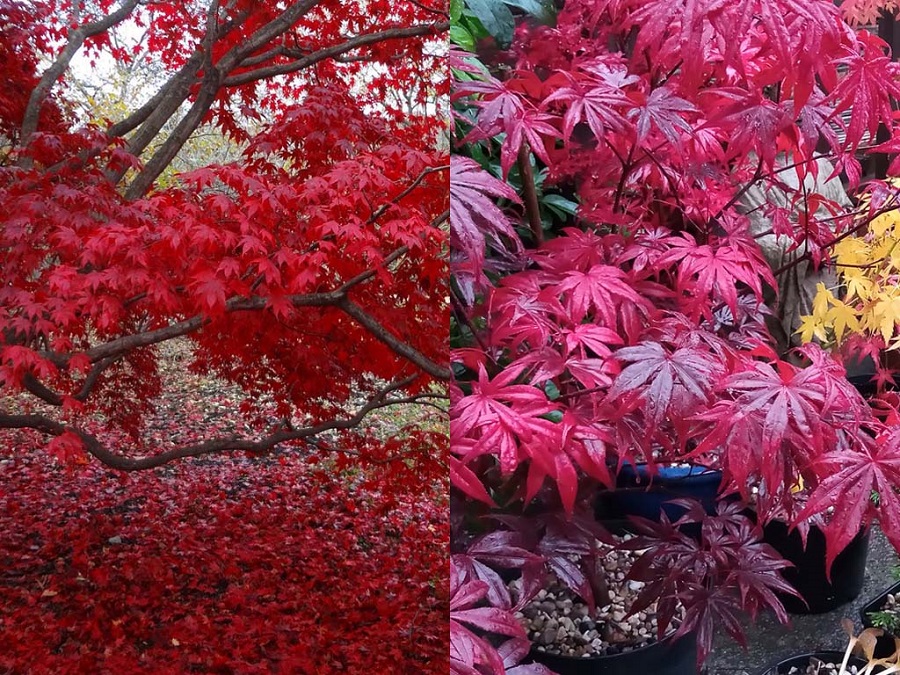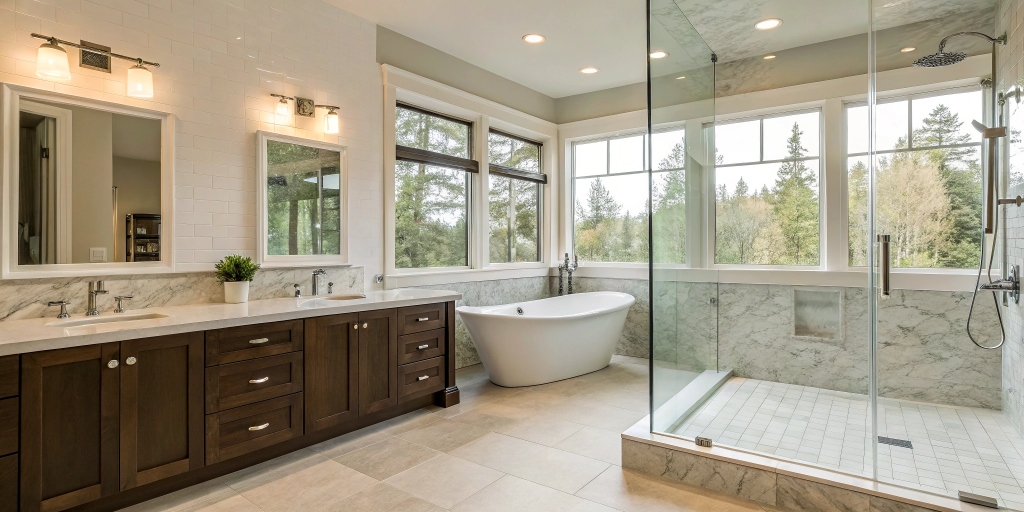Japanese maple trees have captured the hearts of garden enthusiasts worldwide with their striking beauty and unique characteristics. At present, these ornamental trees, native to Japan and other Asian countries, are renowned for their exquisite foliage, vibrant colors, and graceful forms. If you’re considering adding a touch of elegance and tranquility to your garden, understanding the different types of Japanese maple trees is essential. In this guide, we’ll explore the fascinating world of Japanese maple trees, learn about their various varieties, red maple vs Japanese maple and discover how to care for and incorporate them into your landscape.
Understanding and Identifying Maple Trees
Japanese maple trees (Acer palmatum) are highly prized for their exceptional beauty and aesthetic appeal. These deciduous trees are renowned for their delicate, palm-shaped maple tree leaves and ability to transform from vivid greens in spring to fiery reds, oranges, and yellows in autumn. Their graceful branching patterns and attractive bark add interest and elegance to any garden setting.
Currently, over 120 species of maple trees are found in various colors, including red, orange, yellow, and green. Maple trees are also known for their sap, which can be used to make maple syrup.
Here are some tips for identifying maple trees:
- Look for the maple tree leaves. Maple trees have leaves with five lobes. The lobes are usually pointed and can be of various colors, including red, orange, yellow, and green.
- Look for the bark. Maple trees have bark that is typically smooth and gray. However, some species of maple trees have fissured or flaky bark.
- Look for the seeds. Maple trees produce seeds that are called samaras. Samaras are winged seeds that are attached to a central stalk. They look like helicopters, and they can be blown by the wind.
If you see a tree with five-lobed leaves, smooth gray bark, and samaras, it is likely a maple tree. However, other trees have similar features, so it is always best to consult with a professional if you are unsure of the identity of a tree.
Varieties of Japanese Maple Trees
Japanese maple trees encompass various cultivars, each exhibiting unique leaf shapes, colors, and growth habits. Let’s delve into three main categories: Acer Palmatum, Acer Japonicum, and Acer Shirasawanum.
Acer Palmatum Varieties
Acer Palmatum cultivars, or Japanese maples, are the most widely recognized and cultivated type of Japanese maple tree. These varieties feature a broad spectrum of leaf shapes, colors, and sizes, making them highly sought after by garden enthusiasts. From the delicate, lace-like leaves of the ‘Dissectum’ group to the vibrant hues of the ‘Sango Kaku’ cultivar, Acer Palmatum trees offer endless possibilities for adding drama and beauty to your garden.
One notable example is the ‘Bloodgood’ Japanese maple, which boasts deep red leaves throughout the growing season. Its compact size and ability to withstand sun and heat make it a popular choice for small and large gardens.
Acer Japonicum Varieties
Acer Japonicum cultivars, also known as full-moon maples, are characterized by their larger, rounded leaves compared to Acer Palmatum varieties. These trees often exhibit vibrant autumn colors, ranging from bright reds to burnt oranges and deep purples. The ‘Aconitifolium’ variety, with its deeply lobed, fern-like leaves, stands out for its spectacular autumn display and ability to thrive in partially shaded areas.
Acer Shirasawanum Varieties
Acer Shirasawanum cultivars, known as golden full-moon maples, are admired for their unique leaf colors and textures. These trees showcase a range of stunning golden tones, from pale yellows to rich amber hues, which intensify during autumn. The ‘Aureum’ variety, with its vibrant golden foliage, adds a touch of sunshine to any garden and is enchanting when paired with evergreen companions.
Japanese maple vs Red maple: Main Differences
Japanese maples and red maples are beautiful trees that can add a touch of elegance to any landscape. You must know what maple trees look like. However, there are some key differences between the two species.
Japanese maples are native to Japan and China, while red maples are native to North America. Japanese maples are typically smaller than red maples, with a mature height of 10-20 feet. Red maples can grow much larger, with a mature height of 50-70 feet.
Japanese maples are also known for their beautiful foliage. The leaves can be a variety of colors, including red, orange, yellow, and green. Red maples also have colorful leaves, typically red or orange, in the fall.
Another key difference between Japanese maples and red maples is their care requirements. Japanese maples are more sensitive to cold weather than red maples. They also require more sunlight and humidity. Red maples are more tolerant of shade and drought.
A Japanese maple may be a good choice if you want a small, elegant tree with beautiful foliage. A red maple may be a better option if you are looking for a larger, more tolerant tree.
Here is a table comparing the two species:
| Characteristic | Japanese Maple | Red Maple |
| Origin | Japan and China | North America |
| Mature height | 10-20 feet | 50-70 feet |
| Foliage color | Red, orange, yellow, green | Red or orange in the fall |
| Care requirements | More sensitive to cold weather, requires more sunlight and humidity | More tolerant of shade and drought |
How to Identify Maple Trees?
There are many different types of maple trees, but they all share some common characteristics. Maple trees have leaves with five lobes, which are usually pointed. The leaves can be a variety of colors, including red, orange, yellow, and green. Maple trees also have bark that is typically smooth and gray. However, some species of maple trees have fissured or flaky bark. Maple trees produce seeds that are called samaras. Samaras are winged seeds that are attached to a central stalk. They look like helicopters, and the wind can blow them.
Here are some tips for identifying maple trees:
- Look for the leaves. Maple trees have leaves with five lobes. The lobes are usually pointed and can be of various colors, including red, orange, yellow, and green.
- Look for the bark. Maple trees have bark that is typically smooth and gray. However, some species of maple trees have fissured or flaky bark.
- Look for the seeds. Maple trees produce seeds that are called samaras. Samaras are winged seeds that are attached to a central stalk. They look like helicopters, and the wind can blow them.
If you see a tree with five-lobed leaves, smooth gray bark, and samaras, it is likely a maple tree. However, other trees have similar features, so it is always best to consult with a professional if you are unsure of the identity of a tree.
Growing and Caring for Japanese Maple Trees
Successfully growing and caring for Japanese maple trees requires attention to their specific needs. Here are some essential tips to ensure their health and vitality:
- Selecting the right location: Japanese maple trees thrive in well-drained soil and prefer partial shade or filtered sunlight to protect their delicate maple tree leaves from scorching. Avoid planting them in windy or exposed areas.
- Soil requirements and preparation: Prepare the soil by incorporating organic matter to improve drainage and fertility. Japanese maple trees prefer slightly acidic soil with a pH between 5.5 and 6.5.
- Watering, fertilizing, and pruning guidelines: Provide regular watering, especially during dry spells, ensuring the soil remains moist but not waterlogged. Use a balanced fertilizer formulated for acid-loving plants in spring and early summer. Prune selectively to enhance the tree’s natural form and remove damaged or crossing branches.
- Protection from pests and diseases: Japanese maple trees are generally resistant to pests and diseases. However, regular inspections and prompt treatment for aphids, spider mites, and fungal issues are essential to maintain their health.
By following these guidelines, you can create an optimal environment for your Japanese maple trees to flourish and delight you with their captivating beauty.
Landscaping with Japanese Maple Trees
The versatility and visual appeal of Japanese maple trees make them an excellent choice for various garden styles. Whether you have a traditional, modern, or Asian-inspired landscape, here are some ideas for incorporating Japanese maple trees into your garden design:
- Japanese-inspired garden: Japanese maple trees are a quintessential element of traditional Japanese gardens. Plant them near water features, stone lanterns, or alongside moss-covered rocks for an authentic Zen ambiance.
- Accent tree: Use a Japanese maple tree as a focal point in your garden by planting it against a neutral backdrop. The vibrant foliage will create a striking contrast, drawing attention and adding depth to the landscape.
- Container gardening: Japanese maple trees are well-suited for growing in containers, making them ideal for small gardens, patios, or balconies. Choose compact varieties and select a container that allows for proper drainage.
- Color-themed garden: Create a color-coordinated garden by combining Japanese maple trees with plants that complement or contrast their foliage hues. For example, pair a red-leafed Japanese maple with white-flowering shrubs or groundcovers to create a captivating visual impact.
When incorporating Japanese maple trees into your landscape, remember to consider their mature size, growth habit, and color changes throughout the seasons. This will ensure a harmonious and visually pleasing garden composition.
Common Problems and Solutions
While Japanese maple trees are generally hardy and resilient, they can encounter certain issues. Here are some common problems you might encounter and their respective solutions:
- Leaf scorch: This occurs when the tree is exposed to excessive sun or wind. Provide partial shade or windbreaks to protect the leaves and ensure adequate moisture.
- Aphid infestation: Aphids can distort new growth and leave a sticky residue. Use insecticidal soap or a strong water spray to remove aphids from the leaves. Introduce natural predators like ladybugs to control their population.
- Fungal diseases: Powdery mildew and root rot can affect Japanese maple trees. Ensure good air circulation, avoid overhead watering, and apply fungicides as recommended.
- Winter damage: Harsh winters can cause damage to young or unprotected trees. Mulch the tree’s base and wrap the trunk with burlap to provide insulation and protection from freezing temperatures.
Regular inspections, proper maintenance, and prompt action are key to keeping your Japanese maple trees healthy and thriving.
Japanese Maple Trees in Different Seasons
One of the remarkable aspects of Japanese maple trees is their ability to transform throughout the seasons, offering a captivating display year-round. Let’s explore how these trees evolve during each season:
- Spring: As the weather warms, Japanese maple trees produce fresh, vibrant foliage in various shades of green. The delicate leaves unfurl, adding a sense of renewal and vitality to the landscape.
- Summer: During summer, the foliage of Japanese maple trees reaches its fullness. The leaves provide shade and create a cooling effect in the garden. Some varieties may exhibit subtle changes in leaf color or variegation patterns.
- Autumn: Autumn is when Japanese maple trees truly shine, captivating onlookers with their fiery reds, oranges, and yellows. The entire tree transforms into a masterpiece of color, making it the star attraction of any autumn landscape.
- Winter: Although Japanese maple trees lose their leaves in winter, their distinctive branching patterns and attractive bark come into focus. Against a backdrop of snow or a muted winter landscape, the tree’s silhouette adds elegance and interest to the garden.
Witnessing the ever-changing beauty of Japanese maple trees throughout the seasons is a rewarding experience connecting you to nature’s rhythm.
Japanese Maple Trees: Symbolism and Cultural Significance
The Japanese maple tree holds deep symbolism and cultural significance in Japanese culture. Revered for its elegance, resilience, and ability to evoke a sense of tranquility, the Japanese maple has become an integral part of Japanese gardens, art, and literature. Its presence in traditional Japanese tea gardens, bonsai displays, and kimono patterns reflects its enduring cultural importance. Also, it is important to know what do maple trees look like.
The Japanese maple tree is often associated with balance, harmony, and the changing seasons—themes deeply ingrained in Japanese philosophy and aesthetics. Its graceful form and ability to transform throughout the year reflect the impermanence and transience of life, reminding us to embrace the beauty in each passing moment.
Buying and Planting Japanese Maple Trees
When purchasing Japanese maple trees, selecting healthy specimens from reputable nurseries is crucial. Consider the following tips to ensure a successful purchase and planting process:
- Choose a reliable nursery: Look for nurseries with a good reputation and knowledgeable staff. They can guide you in selecting suitable varieties based on your garden’s conditions and preferences.
- Inspect the tree: Examine the tree for signs of disease or pest infestations. Ensure the foliage is healthy, the branches are well-formed, and the root system is well-developed.
- Planting guidelines: Select an appropriate location that provides partial shade and well-drained soil. Dig a wider and slightly shallower hole than the tree’s root ball. Place the tree in the hole, backfill it with soil, and water thoroughly.
- Post-planting care: Mulch the tree’s base to retain moisture and suppress weeds. Regularly water the tree, especially during dry periods. Monitor its growth and address any issues promptly.
By following these steps, you can establish a strong foundation for your Japanese maple tree’s growth and ensure its long-term success in your garden.
Pruning and Shaping Japanese Maple Trees
Pruning Japanese maple trees is essential to maintain their shape, enhance their natural form, and promote overall tree health. Here are some guidelines for pruning and shaping these beautiful trees:
- Timing: Pruning is best done during late winter or early spring when the tree is dormant. This allows you to see the tree’s branching structure clearly and minimizes the risk of disease transmission.
- Selective pruning: Focus on removing dead, damaged, or crossing branches. Prune to open up the canopy and improve air circulation, which reduces the risk of fungal diseases.
- Shaping: Prune for shape if you desire a more compact or specific form. However, avoid excessive pruning, as it can weaken the tree and lead to stress.
- Pruning techniques: Use sharp, clean tools to make precise cuts. Avoid leaving stubs or making flush cuts, as this can hinder the tree’s healing process. Make cuts just outside the branch collar, the swollen area where the branch connects to the trunk.
Remember, pruning Japanese maple trees aims to maintain their natural grace and form. By following proper pruning techniques, you can ensure the tree remains healthy and visually appealing for years.
What types of Japanese maple trees are suitable for home gardens?
Many different types of Japanese maple trees are suitable for home gardens. Some of the most popular varieties include:
- Acer palmatum atropurpureum ‘Bloodgood’: This variety has dark purple leaves that turn crimson red in the fall. It is a slow-growing tree that can reach 15 to 20 feet.
- Acer palmatum dissectum ‘Shaina’: This variety has deeply dissected leaves that are green in summer and turn yellow, orange, and red in the fall. It is a slow-growing tree that can reach 10 to 15 feet.
- Acer palmatum ‘Osakazuki’: This variety has bright red leaves that turn orange and yellow in the fall. It is a fast-growing tree that can reach 20 to 30 feet.
- Acer palmatum ‘Senkaki’: This variety has yellow leaves that turn orange and red in the fall. It is a slow-growing tree that can reach 10 to 15 feet.
- Acer palmatum ‘Shindeshojo’: This variety has coral-red leaves that turn orange and yellow in the fall. It is a slow-growing tree that can reach 10 to 15 feet.
When choosing a Japanese maple tree for your home garden, it is important to consider the size of the tree, the color of the leaves, and the amount of sunlight the tree will receive. Japanese maple trees can be grown in full sun or partial shade, but they will not do well in full sun in hot climates.
Frequently Asked Questions (FAQs)
Q: Can I grow Japanese maple trees in containers?
A: Yes, many Japanese maple varieties are well-suited for container gardening. Choose compact varieties and ensure the container provides proper drainage.
Q: How often should I water my Japanese maple tree?
A: Watering requirements vary based on climate and soil conditions. Generally, it’s best to keep the soil moist but not soggy. Adjust the watering frequency based on weather conditions.
Q: Do Japanese maple trees require full sun?
A: Japanese maple trees prefer partial shade or filtered sunlight. They can tolerate morning sun and afternoon shade but may suffer leaf scorch in intense or prolonged sun exposure.
Q: Can Japanese maple trees tolerate cold winters?
A: Most Japanese maple varieties are hardy and can withstand cold winters. However, young or recently planted trees may benefit from additional protection, such as mulching the base and wrapping the trunk with burlap.
Q: How long does a Japanese maple tree take to mature?
A: The time it takes for a Japanese maple tree to reach maturity varies depending on the variety and growing conditions. A Japanese maple can take 10 to 15 years to fully mature.
Conclusion
Japanese maple trees are exquisite additions to any garden, captivating with their unique foliage, graceful forms, and vibrant colors. You can create a tranquil and visually stunning outdoor space by understanding the different types of Japanese maple trees, identifying maple trees, caring for their specific needs, and incorporating them into your landscape. Remember to choose the right variety, provide suitable growing conditions, and engage in proper maintenance to ensure these magnificent trees’ long-term health and beauty.






